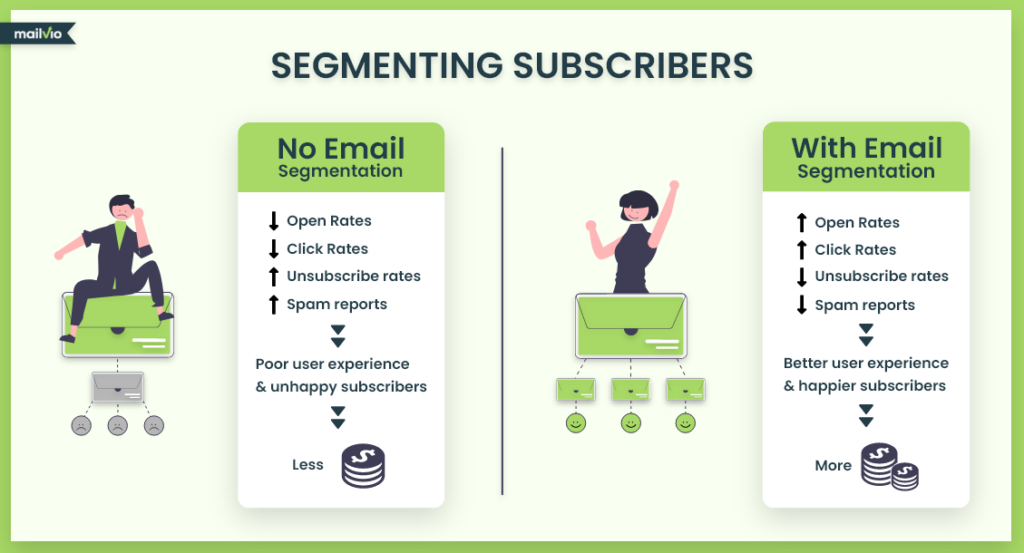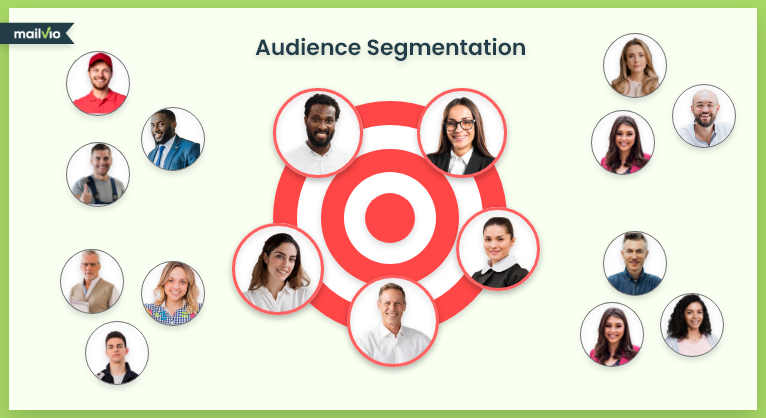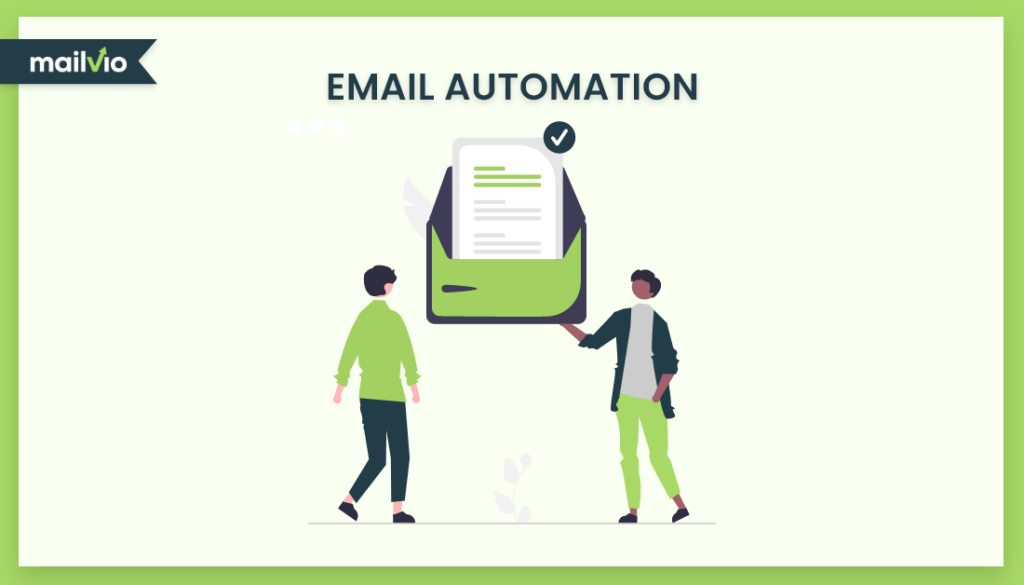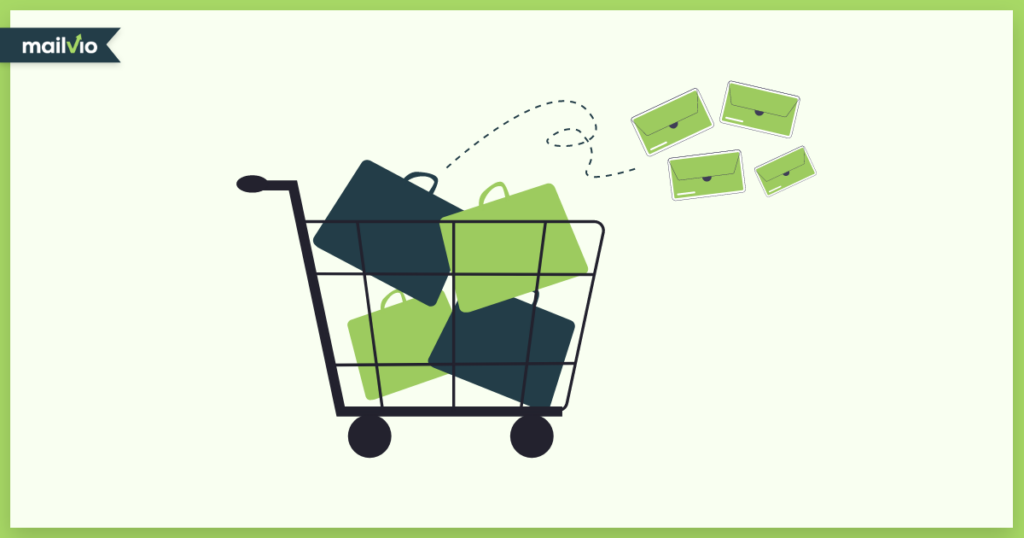Email segmentation is more than just a marketing buzzword – it’s the influencer’s secret to making a real impact.
In a world where authenticity and personalized connections reign supreme, email marketing thrives on reaching the right audience with the right message.
It all comes down to cutting through the noise and delivering content that truly resonates with your followers.
In this article, we’ll take a deep dive into the realm of email segmentation strategies for influencers,’ shedding light on the techniques and tactics that can redefine your email marketing game.
The Basics of Email Segmentation for Influencers

It’s time to dig deeper into the fundamental principles that form the foundation of email segmentation for influencers.
By grasping these essentials, you’ll be better equipped to:
- engage your diverse audience,
- foster authenticity, and
- drive meaningful results in your influencer marketing efforts:
Definition of Email Segmentation
Email segmentation is the practice of dividing your email list into smaller, more targeted segments based on specific criteria or characteristics.
It allows you to send tailored and relevant content to different groups of recipients, rather than sending a generic message to your entire list.
By categorizing your subscribers, you can provide them with content that aligns with their interests, preferences, and behaviors.
For instance, you might segment your email list based on factors (more on this later) such as:
- demographics (age, gender, location),
- engagement level (active, inactive),
- purchase history, or
- content preferences.
This definition underscores the core concept of email segmentation, which is to enhance the effectiveness of your email marketing by sending the right message to the right people.
Specific Relevance of Email Segmentation for Influencers
Email segmentation holds particular importance for influencers due to the nature of their work.
Influencers often have diverse follower bases, each with unique interests, demographics, and preferences.
To maximize their impact and engagement, they need to create content that resonates with these varied groups.
Segmentation allows influencers to tailor their email campaigns to different audience segments.
For example, they can send beauty-related content to followers interested in cosmetics, while sending fitness tips to those interested in health and wellness.
This specific relevance enhances the likelihood of engagement and conversion, as the content directly speaks to the interests of the recipient.
Furthermore, email segmentation enables influencers to maintain a personal and authentic connection with their audience.
Followers appreciate content that feels customized to their needs, and this can lead to increased loyalty and trust in the influencer’s brand.
Benefits of Email Segmentation for Influencers

Email segmentation is a game-changer for influencers. It’s the secret to unlocking several key advantages that can significantly elevate your influencer marketing efforts.
Let’s take a look at these advantages in greater detail:
Improved Engagement and Open Rates:
Engagement and open rates are the lifeblood of influencer email marketing.
In a crowded digital landscape, it’s becoming increasingly challenging to grab your audience’s attention. Email segmentation provides the influencer with a clear advantage.
By breaking down your audience into distinct segments, you can send them content that speaks directly to their preferences.
This level of personalization makes your emails more enticing, increasing the likelihood of recipients opening and engaging with your messages.
In essence, email segmentation helps you cut through the noise and reach your audience on a more personal level.
It’s about sending the right message to the right people at the right time, ultimately creating a stronger bond between you and your followers.
Higher Conversion Rates:
While engaging your audience is essential, what truly matters in influencer email marketing is conversions.
These conversions can take various forms, whether it’s making a purchase, signing up for a newsletter, or participating in a campaign.
Email segmentation empowers influencers to fine-tune their messaging and increase their conversion rates.
As mentioned above, segmenting your email list allows you to send highly targeted content that speaks directly to your audience’s needs and interests.
When recipients receive content that resonates with them, they are more likely to take action.
This, in turn, can lead to repeat interactions, brand advocacy, and long-term customer relationships.
Enhanced Brand Loyalty:
Brand loyalty is the bedrock of any successful influencer marketing endeavor. It’s about nurturing a lasting relationship with your audience and creating a community of engaged followers who trust and value your content.
Email segmentation plays a pivotal role in this journey.
When you segment your email list, you’re not just delivering personalized content. You’re also showing your followers that you understand them and care about their preferences.
Subscribers are more inclined to remain engaged and committed to an influencer’s brand because they consistently receive content that caters to their individual preferences.
This heightened loyalty fosters repeated interactions, encourages brand advocacy, and nurtures enduring customer relationships, solidifying a dedicated and enduring fan base.
Key Segmentation Criteria for Influencers
To tailor content and offers to their diverse audience, influencers rely on key segmentation criteria.
Let’s explore the essential criteria that influencers use to refine their email marketing strategies and deliver content that resonates with their subscribers.
Demographics:

Demographic segmentation is one of the foundational criteria for influencers. It involves categorizing your email subscribers based on their personal characteristics.
These characteristics can include age, gender, income level, education, and more.
For example, a parenting influencer might segment their audience into groups like “New Parents,” “Single Parents,” and “Expecting Parents.”
This allows influencers to tailor their content, product recommendations, and offers to suit the unique needs and preferences of each demographic group.
Geographic Location:
Geographic location segmentation involves categorizing subscribers based on where they live.
For instance, a travel influencer might create segments for subscribers in different regions or countries, allowing them to send location-specific travel tips, recommendations, or event announcements.
This type of segmentation is especially relevant for influencers whose content or promotions are location-specific.
Behavior and Engagement History:
Behavior and engagement history segmentation is based on how subscribers interact with an influencer’s content and emails.
This criterion includes factors like email open rates, click-through rates, social media engagement, and website visits.
For example, an influencer can create segments for “Highly Engaged Subscribers,” “Moderately Engaged Subscribers,” and “Inactive Subscribers.”
By doing so, influencers can send re-engagement emails to inactive subscribers or provide exclusive content and offers to their most engaged audience members.
Content Preferences:
Segmenting based on content preferences involves categorizing subscribers according to their interests or the type of content they engage with the most.
For example, a food influencer may create segments for “Vegetarian Enthusiasts,” “Gluten-Free Dieters,” and “Dessert Lovers.”
Purchase History (If Applicable):
Influencers who sell products or services can segment their email list based on subscribers’ purchase history.
This segmentation criterion allows influencers to:
- recommend related products,
- provide updates on new offerings, or
- offer exclusive discounts to customers who have made previous purchases.
For instance, a fashion influencer can create segments for “Repeat Customers” and “First-Time Shoppers,” tailoring their email content to suit each group’s shopping behavior.
Influencer-Specific Criteria (e.g., Niche, Follower Demographics):
In addition to the general segmentation criteria, influencers may have unique segmentation needs based on their specific brand and goals.
These criteria can include:
- Niche Segmentation: Influencers can segment subscribers based on the specific niche they cover. For example, a tech influencer might have segments like “Gaming Enthusiasts,” “Software Developers,” and “Tech Novices.”
- Follower Demographics: Influencers often have access to insights about their social media follower demographics. These insights can be used to create segments based on the demographics of their social media followers, ensuring that their email content aligns with the broader interests of their audience.
Tips for Effective Email Segmentation
In the following sections, we’ll explore key strategies for effective email segmentation.
These email marketing best practices for influencers, when implemented effectively, can help you harness the full potential of email segmentation and foster deeper connections with your audience.
Collecting and Organizing Data:
Collecting and organizing data is a critical first step in successful email segmentation.
Influencers can use tools like email marketing platforms and CRM systems to collect and organize this data, ensuring that it is up-to-date and easily accessible for segmentation purposes.
As we discussed above, this data might include:
- Demographics: Information such as age, gender, location, and income level. For example, a fashion influencer might segment subscribers by age group, creating categories for young adults, middle-aged individuals, and seniors.
- Behavior: This includes subscriber actions like website visits, email open rates, and product purchases. For instance, a tech influencer may segment subscribers based on whether they have previously purchased a smartphone, laptop, or accessories.
- Interests: Subscribers’ preferences, such as their favorite content topics or product categories. An influencer who covers travel and photography could segment subscribers interested in travel tips separately from those interested in photography gear recommendations.
- Interaction History: Details on how subscribers have engaged with past emails or social media posts. For example, an influencer might segment subscribers who frequently comment on Instagram posts differently from those who seldom interact.
Creating Buyer Personas for Influencers:
Buyer personas are semi-fictional representations of your ideal audience segments. Each persona should include a detailed profile of a typical subscriber within that segment. For influencers, buyer personas help personalize content and messaging.
Creating a buyer persona involves:
- Demographic Information: Include age, gender, location, education, occupation, and more. For instance, a fitness influencer might create a persona for a young, health-conscious urban professional.
- Psychographic Information: Dive into subscribers’ motivations, interests, values, and lifestyles. For example, the persona could reveal that the individual values convenience and is interested in time-efficient workouts and healthy meal prep.
- Challenges and Goals: Understand the specific challenges or pain points the persona faces and their goals. The persona might have challenges related to maintaining a healthy lifestyle, such as finding time to exercise, and a goal of losing weight and improving overall wellness.
Influencers can craft content and offers that resonate with each audience segment by creating detailed buyer personas.
A/B Testing for Segmentation Effectiveness:

A/B testing in influencer email campaigns allows influencers to refine their segmentation strategies and improve their outcomes.
This involves testing different elements within email marketing to determine what works best for each segment.
Some examples of A/B testing in email marketing include:
- Subject Lines: Test different subject lines to determine which generates higher open rates. For instance, an influencer promoting a beauty product could test subject lines like “Get Glowing Skin with Our New Serum” against “Unlock Radiant Skin Secrets.”
- Content Format: Experiment with different content formats, such as long-form articles vs. short, visual-rich newsletters. A travel influencer might test whether subscribers engage more with detailed travel guides or quick destination highlights.
- Call-to-Action (CTA): Test different CTAs to find out which ones drive more conversions. An influencer offering a fitness program might test “Start Your Fitness Journey Today” against “Join Our Community of Health Enthusiasts.”
Regularly conducting A/B tests allows influencers to refine their segmentation strategies and improve email campaign performance.
Tailoring Content to Segmented Groups:
We feel like we are repeating ourselves here, but tailoring content is INDEED crucial to engaging email recipients.
Once influencers have segmented their email list, they should create content that speaks directly to the needs and interests of each group.
Here are some strategies:
- Personalization: Address subscribers by their first name and reference their previous interactions with your content.
- Content Relevance: Create content that aligns with the specific interests of each segment. For example, a travel influencer might send destination recommendations to adventure-seekers and cultural insights to history enthusiasts.
- Product Recommendations: For influencers promoting products or services, recommend items that are relevant to each segment. An influencer in the parenting niche could promote different baby products to first-time parents and experienced parents.
- Timing: Send emails at times when each segment is most likely to engage. For instance, a food influencer may find that subscribers interested in dinner recipes engage more on weekday evenings, while those interested in brunch ideas are active on weekends.
Automating Segmentation Processes:

Automation streamlines the email segmentation process, making it more efficient and ensuring timely communication with subscribers.
Here’s how influencers can automate segmentation using a tool like Mailvio:
- Behavior-Based Triggers: Set up automation rules that segment subscribers based on their behavior, such as website visits, email opens, or product purchases. For instance, an influencer could automatically tag subscribers who have made a purchase and send them post-purchase emails.
- Welcome and Onboarding Sequences: Automate welcome emails and onboarding sequences to introduce new subscribers to your content and services. Tailor these sequences to the interests and preferences identified during the signup process.
- Scheduled Email Campaigns: Plan and schedule email campaigns in advance, ensuring that each segment receives content at the optimal time. For example, a travel influencer can schedule newsletters with destination recommendations well in advance.
- Dynamic Content: Use dynamic content within emails to personalize content for different segments. For instance, an influencer offering courses could use dynamic content to display different offerings based on the subscriber’s interests and previous interactions.
Practical Strategies and Tricks for Email Segmentation
Let’s dive deep into some of the most practical email segmentation strategies that influencers can employ to enhance the effectiveness of their email marketing efforts.
These techniques go beyond the fundamentals and offer influencers creative ways to engage with their audience and boost their impact:
Dynamic Content and Personalization:
Dynamic content and personalization add a personalized touch to email marketing, making subscribers feel more valued.
Instead of sending generic emails, influencers can use data gathered through segmentation to tailor the content for each subscriber.
For instance, a beauty influencer can include the subscriber’s first name in the email and recommend products based on their past purchases.
Dynamic content can also be used to display different product recommendations, images, or call-to-action buttons depending on the subscriber’s preferences and behaviors.
This level of personalization not only increases open rates but also drives higher conversion rates, as we already discussed above.
Drip Campaigns and Sequencing:
Drip campaigns and sequencing involve sending a series of emails to subscribers over time, creating a structured and engaging customer journey.
Influencers can use this approach to nurture leads, provide value, and gradually introduce their brand and offerings.
For instance, a fitness influencer could initiate a drip campaign by sending a welcome email to new subscribers, followed by a series of emails containing workout tips, nutrition advice, and success stories.
As subscribers progress through the sequence, they receive increasingly targeted and valuable content, eventually leading to a call to action, such as signing up for a fitness program or purchasing workout equipment.
Re-engagement Tactics:

Re-engagement tactics are essential for revitalizing the interest of subscribers who have become less engaged over time.
Influencers can identify dormant subscribers and send them re-engagement emails that offer incentives or exclusive content.
For example, a travel influencer might send a re-engagement email with a special discount code for subscribers who haven’t opened their emails in a while.
This can be an effective way to bring subscribers back into the active engagement fold and prevent them from unsubscribing.
Using Social Proof and Endorsements:
Leveraging social proof and endorsements can boost trust and credibility in influencer email marketing.
Influencers can include elements like customer reviews, testimonials, or endorsements from other influential figures in their emails.
For instance, a tech influencer can highlight positive customer reviews alongside product recommendations, demonstrating the value and quality of the recommended tech gadgets.
The social proof not only validates the influencer’s recommendations but also encourages subscribers to make informed purchase decisions.
Leveraging User-Generated Content:
User-generated content (UGC) is a powerful tool for building a sense of community and authenticity among subscribers.
Influencers can encourage their audience to create and share content related to their niche, such as photos, reviews, or stories, and then feature this UGC in their emails.
For example, a food influencer can include photos of subscribers’ homemade dishes, along with their recipes, in a newsletter.
This not only showcases the diversity of the influencer’s community but also creates a stronger bond between the influencer and their audience, as subscribers see their contributions recognized and valued.
Timing and Frequency Considerations:
Timing and email frequency are key considerations to maximize engagement. Influencers should experiment with various send times and frequencies to determine what works best for their audience segments.
For instance, a fashion influencer might find that sending emails featuring the latest trends in the late afternoon, just before subscribers start their evening routines, leads to higher open and click-through rates.
Additionally, segmenting the audience based on their preferred email frequency can help prevent email fatigue and ensure that subscribers receive content when they are most receptive.
Challenges and Pitfalls In Influencer Email Segmentation
Influencer email segmentation is not without its challenges and common pitfalls.
Here are some of the most common influencer email marketing mistakes and how to address (or avoid) them to properly segment your email lists:
Having Inaccurate or Outdated Data:
Keeping subscriber data accurate and up-to-date is a common challenge for influencers.
Over time, data can become outdated due to changes in subscribers’ information or disengagement.
Using inaccurate or outdated data for segmentation decisions can result in sending irrelevant content to subscribers. This inevitably leads to decreased engagement and causes some subscribers to unsubscribe.
To mitigate this issue, influencers must implement strategies for list cleaning and validation.
Regularly verifying and updating subscriber information, along with cleaning out inactive or obsolete records, can help maintain data accuracy.
Additionally, requesting subscribers to periodically review and update their preferences can contribute to more precise segmentation decisions.
Segmenting Too Broadly or Narrowly:
Finding the right balance in segmentation can be a challenge for influencers.
Segmenting too broadly leads to a situation where content becomes generic and fails to resonate with anyone.
Over-segmenting, on the other hand, results in numerous small and less engaged segments.
The challenge is to identify the sweet spot where segmentation is neither too broad nor too narrow.
Influencers can address this by regularly analyzing the performance of their segments and adjusting their criteria accordingly.
Paying attention to engagement metrics, like open rates and click-through rates, can help determine whether segments need to be consolidated or further refined.
The goal is to create segments that are large enough to be relevant but distinct enough to receive tailored content.
Lack of Automation:
Managing email segmentation can be resource-intensive, and many influencers may not have the necessary tools or staff to handle it effectively.
Automation offers a practical solution to streamline the segmentation process and ease the burden on influencers.
However, investing in robust automation tools can be costly. For those seeking cost-effective solutions, platforms like Mailvio are worth exploring.
Mailvio is an extremely affordable email marketing platform that influencers can use to segment their lists based on subscriber behavior, demographics, and engagement levels.
On top of that, influencers can benefit from using email marketing tools like Mailvio thanks to its A/B testing capability and robust reporting & analytics.

As mentioned above, A/B testing allows influencers to experiment with different email content to understand what resonates best with their audience.
This feature provides insights into the most effective segmentation strategies, helping influencers refine their approaches.
Additionally, Mailvio’s reporting and analytics tools offer in-depth data on subscriber interactions, open rates, click-through rates, and more.
This data equips influencers with a better understanding of their audience’s preferences and behaviors, which, in turn, informs more precise and successful email segmentation.
Inconsistent Messaging Across Segments:
Ensuring consistent messaging while catering to the unique needs of each segment can be a challenge for influencers.
Maintaining a uniform brand voice and message across all segments is vital for a cohesive brand identity.
However, customization is also necessary to provide relevant content to each group. The challenge is to strike a balance that delivers both consistency and personalization.
Influencers can overcome this challenge by developing a clear brand messaging framework that allows for flexibility while adhering to the brand’s core values and voice.
Creating standardized messaging templates and guidelines can help maintain consistency while tailoring specific content to meet the needs of different segments.
Influencers must regularly review their messaging strategies to ensure they strike the right balance.
Segmentation Bias:
Unconscious bias in segmentation is a risk for influencers, particularly when they have segments with larger or more engaged audiences.
Neglecting smaller or less active segments can lead to missed opportunities for engagement and conversion.
To address this challenge, influencers should adopt a data-driven and objective approach to segmentation.
Regularly review segment performance metrics and compare the effectiveness of smaller segments with larger ones.
By consistently analyzing and adapting to data trends, influencers can ensure that they are giving equal attention to all segments, regardless of their size or historical engagement levels.
Ignoring Feedback and Adaptation:
Setting up segmentation criteria and then neglecting to revisit and adapt them based on changing audience preferences or feedback is a common pitfall.
Subscriber behavior and preferences evolve over time, and influencers need to stay attuned to these changes to maintain effective segmentation.
Ignoring feedback and failing to adapt can lead to declining engagement rates. To avoid this pitfall, influencers should implement a robust feedback and monitoring system.
Encourage subscribers to provide feedback and preferences regularly. Analyze engagement data to identify trends and changes in subscriber behavior.
Periodically review and adjust segmentation criteria to ensure they align with current audience preferences and behaviors.
Neglecting Mobile Optimization:
Neglecting mobile optimization is a common pitfall for influencers, as about 85% of people use mobile to access their emails.
When emails are not properly optimized for mobile, subscribers may encounter difficulties in viewing and interacting with the content. This, in turn, results in poor user experiences and reduced engagement.
To address this challenge, influencers must prioritize responsive email design.
This involves creating emails that adapt to different screen sizes, ensuring that they display correctly on both desktop and mobile devices.
Additionally, influencers should rigorously test their emails on various mobile platforms and devices to guarantee a seamless user experience.
Neglecting mobile optimization can lead to missed opportunities, as it can deter subscribers from engaging with content or taking desired actions.
Final Thoughts
Email segmentation remains a cornerstone for influencers looking to foster meaningful connections with their audience.
While it can present challenges, mastering this practice is essential for driving engagement and campaign success.
To refine your email segmentation strategy, remember to prioritize audience understanding and use data-driven insights.
Tailor your content and offers to these segments, ensuring relevance and value for your subscribers.
Also, don’t forget to embrace automation to streamline the process and make the most of your resources.
To put these principles into action, we encourage you to sign up for Mailvio’s 7-day free trial.
Use this trial period to assess how Mailvio can streamline your email marketing efforts, freeing up your time to concentrate on content creation and audience engagement.
Sign up now and elevate your email segmentation strategy today.

